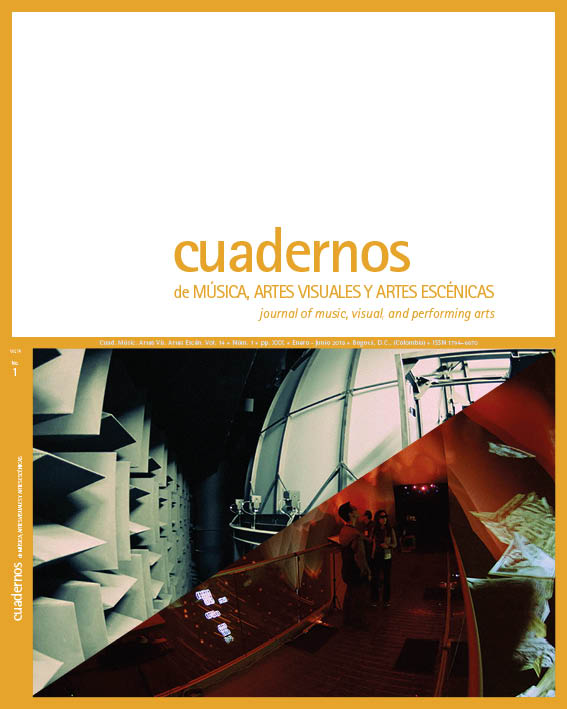Abstract
This article aims to be an analytical-reflective approach to the role of the musical interpreter in the field of contemporary and experimental music today. From its origins and from the moment in which the interpreter was separated from the figure of the composer, their functions and ways of approaching music, their study and interpretation have been changing. These variations, however, remain closely linked to the changes of currents and compositional visions and how they define the concepts of musical idea, creative process or sound result. The term used to describe this new type of performer, extended performer, refers to how this function has been extended, expanded, beyond the limits of an instrumental or performative practice. Profiling the historical origins of the musical performer and going through the paradigm changes that took place during the 20th century with the different avant-garde currents and with proper names, such as John Cage or Pierre Boulez, we will reach the aforementioned extended performer of the present, exemplifying this new figure through current compositional movements, the importance of digitization in art and how it has raised a new relationship between the performer and their instrument.
Cage, John. 1973. Silence. Hanover: Wesleyan University Press.
Danuser, Hermann. 2016. “Interpretación”. Revista de Musicología 39 (1): 19-45. DOI: 10.2307/24878536.
Echeverría, Bolívar. 2003. Introducción a La obra de arte en la época de su reproductibilidad técnica, de
Walter Benjamin, 9-28, México: Itaca.
Erwin, Max. 2016. “Here comes Newer Despair: An Aesthetic Primer for the New Conceptualism of
Johannes Kreidler”. Tempo 70 (278): 5-15. https://www.cambridge.org/core/journals/tempo/article/
here-comes-newer-despair-an-aesthetic-primer-for-the-new-conceptualism-of-johannes-kreidler/156
3136B03BB2DBD63CB264D12D6F572.
Fernández Guerra, Jorge. 1985. Pierre Boulez. Madrid: Círculo de Bellas Artes.
Fuhrmann, Wolfgang. 2011. “Toward a Theory of Socio-Musical Systems: Reflections on Niklas Luhmann’s
Challenge to Music Sociology”. Acta Musicologica 83 (1): 135-159.
Gadamer, Hans-Georg. 1996. Estética y hermenéutica. Madrid: Tecnos.
Gottstein, Björn. 2011. “Digitalisierung und Musik / ein (Streit-) gespräch zwischen Claus-Steffen Mahnkopf
und Johannes Kreidler ; moderiert von Björn Gottstein”. Musik Texte Köln 128.
Hegel, Georg W. Friedrich. 1985. Estética: la pintura y la música. Buenos Aires: Siglo XXI.
“Interpretar”. 2014. Diccionario de la lengua española. http://dle.rae.es/?id=LwUON38.
Kreidler, Johannes. 2009. “Fremdarbeit”. https://www.youtube.com/watch?v=L72d_0zIT0c&feature=youtu.be.
— 2011. Musik mit Musik: Texte 2005-2011. Múnich: Volke-Verlag.
Kreidler, Johannes, Harry Lehmann y Claus-Steffen Mahnkopf. 2010. Musik, Ästhetik, Digitalisierung: Eine
Kontroverse. Hofheim: Wolke.
“minusBolero”. 2015. Kreidler-net. http://www.kreidler-net.de/theorie/minusbolero.pdf.
Nelson, Peter. 1999. “El cyborg musical”. En Música y nuevas tecnologías: perspectivas para el siglo XXI,
de Eduardo Reck Miranda, 69-83. Barcelona: L’Angelot.
Pardo Salgado, Carmen. 1999. “Interpret/acción”. Contrastes: Revista Internacional de Filosofía 4: 135-148.
DOI: http://dx.doi.org/10.24310/Contrastescontrastes.v0i0.1508
— 2014. La escucha oblicua: una invitación a John Cage. Madrid: Ensayo Sexto Piso.
Rivière Ríos, Henar. 2011. “Papeles para la historia de Fluxus y Zaj: entre el documento y la práctica
artística”. Anales de Historia del Arte, Volumen Extraordinario: 421-436.
“Stefan Prins”. 2012. Stefanprins.be. http://www.stefanprins.be/eng/composesChrono/comp_2012_03.html
Stravinsky, Igor. 2006. Poética musical. Barcelona: Acantilado.
Esta revista científica se encuentra registrada bajo la licencia Creative Commons Reconocimiento 4.0 Internacional. Por lo tanto, esta obra se puede reproducir, distribuir y comunicar públicamente en formato digital, siempre que se reconozca el nombre de los autores y a la Pontificia Universidad Javeriana. Se permite citar, adaptar, transformar, autoarchivar, republicar y crear a partir del material, para cualquier finalidad, siempre que se reconozca adecuadamente la autoría, se proporcione un enlace a la obra original y se indique si se han realizado cambios. La Pontificia Universidad Javeriana no retiene los derechos sobre las obras publicadas y los contenidos son responsabilidad exclusiva de los autores, quienes conservan sus derechos morales, intelectuales, de privacidad y publicidad.
El aval sobre la intervención de la obra (revisión, corrección de estilo, traducción, diagramación) y su posterior divulgación se otorga mediante una licencia de uso y no a través de una cesión de derechos, lo que representa que la revista y la Pontificia Universidad Javeriana se eximen de cualquier responsabilidad que se pueda derivar de una mala práctica ética por parte de los autores. Como consecuencia de la protección brindada por la licencia de uso, la revista puede publicar retractaciones o corregir la información ya publicada. La publicación de contenidos en esta revista no representa regalías para los contribuyentes.



